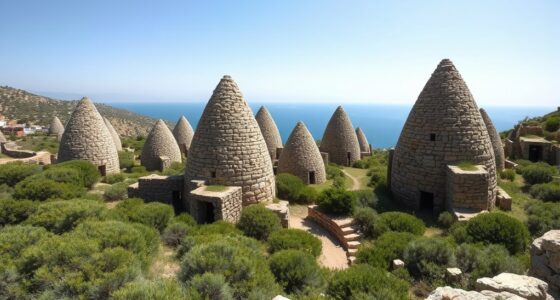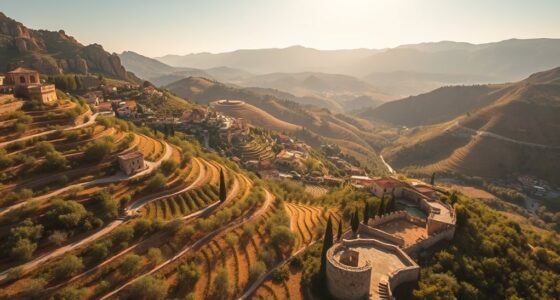Exploring Nuraghe and Prehistoric Sardinia lets you uncover ancient architecture dating back to the 18th century B.C., unique to this island. You’ll see how these stone structures evolved from simple dwellings into complex fortresses with multiple towers, symbols of power and community. Their strategic locations, religious significance, and craftsmanship reveal a rich prehistoric culture. Want to understand their mysteries and how they shaped Sardinia’s history? Keep exploring to discover more about these fascinating monuments.
Key Takeaways
- Nuraghi are ancient Sardinian stone structures dating back to the 18th century B.C., symbolizing prehistoric cultural development.
- Built from large dry stones, nuraghi served as forts, religious sites, and community centers with complex architectural features.
- Their strategic locations and defensive designs highlight their roles in protection, territorial control, and social organization.
- Archaeological findings include artifacts, sacred wells, and tombs, revealing religious practices and daily life in prehistoric Sardinia.
- Nuraghi sites like Su Nuraxi attract tourism, supporting economic growth and cultural heritage preservation on the island.
The Origins and Construction of Nuraghi
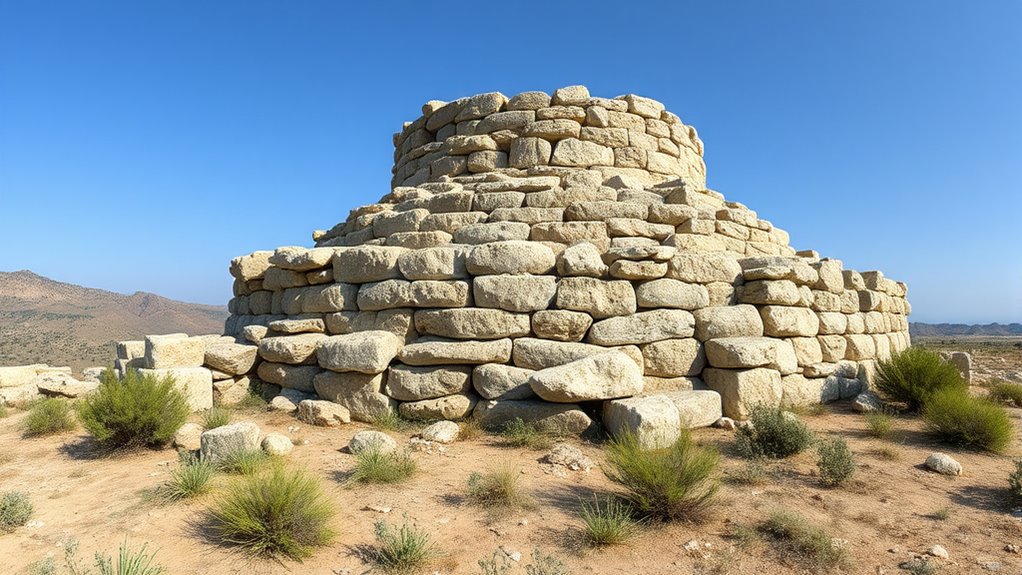
The origins of nuraghi date back to the 18th century B.C., making them some of the oldest monumental structures in the Mediterranean. You can trace their development entirely within Sardinia, with no clear foreign prototypes, though some believe they reflect Aegean or Mediterranean influences. Early nuraghi evolved from simpler “corridor” types, featuring low platforms and interior passageways, and about 180 examples remain across the island. Built from large local stones using dry masonry, these structures relied on precise placement rather than mortar for stability. Despite their massive exterior, their interior spaces are modest, indicating they served specialized functions rather than residential ones. Their construction required organized labor and resource management, reflecting a society capable of planning and executing complex projects over centuries. The Nuragic culture’s advanced social organization and engineering skills, including the ability to mobilize large workforces and utilize local materials, demonstrate their remarkable capabilities.
Architectural Features and Engineering Techniques
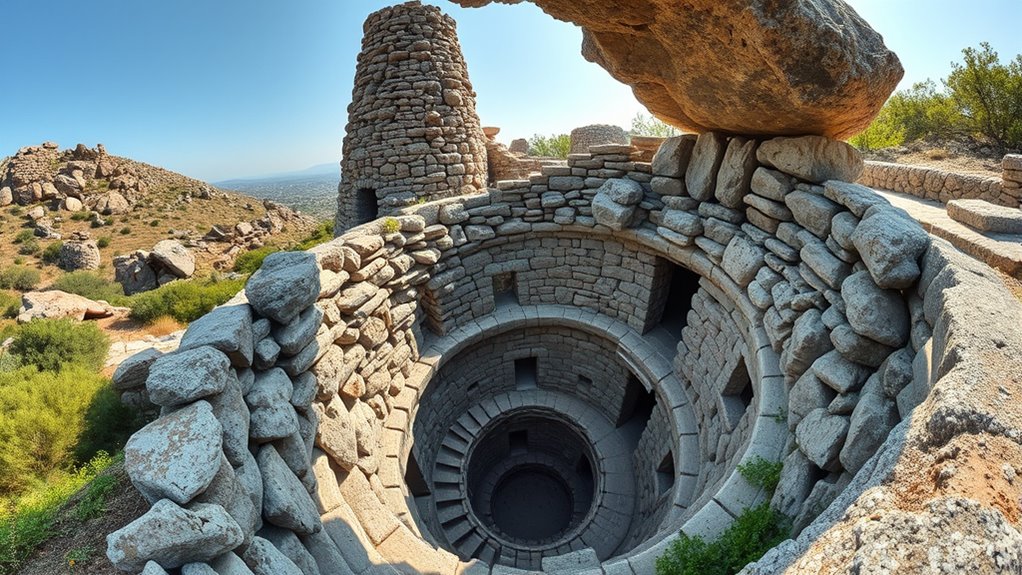
Nuraghi showcase remarkable architectural features and engineering techniques that highlight the ingenuity of prehistoric builders. These structures are primarily circular towers with a truncated conical shape, featuring a beehive interior and exterior resembling medieval fortifications. Many include multiple towers connected by curtain walls, forming bastions for defense. Inside, multi-level chambers with False vaulted ceilings are built using corbeling, while spiral staircases maximize space and stability. Construction employs dry stone masonry, with stones carefully fitted without mortar, often in cyclopean style. Some towers reach 30 meters tall, demonstrating advanced understanding of weight distribution and stability. Thick walls and layered stones distribute loads efficiently, ensuring durability. Variations in design, from simple single towers to complex complexes with corridors and subsidiary chambers, reflect increasing sophistication in prehistoric engineering. Additionally, the use of advanced construction techniques indicates a high level of engineering knowledge and adaptability in prehistoric Sardinian societies.
The Role of Nuraghi in Ancient Sardinian Society
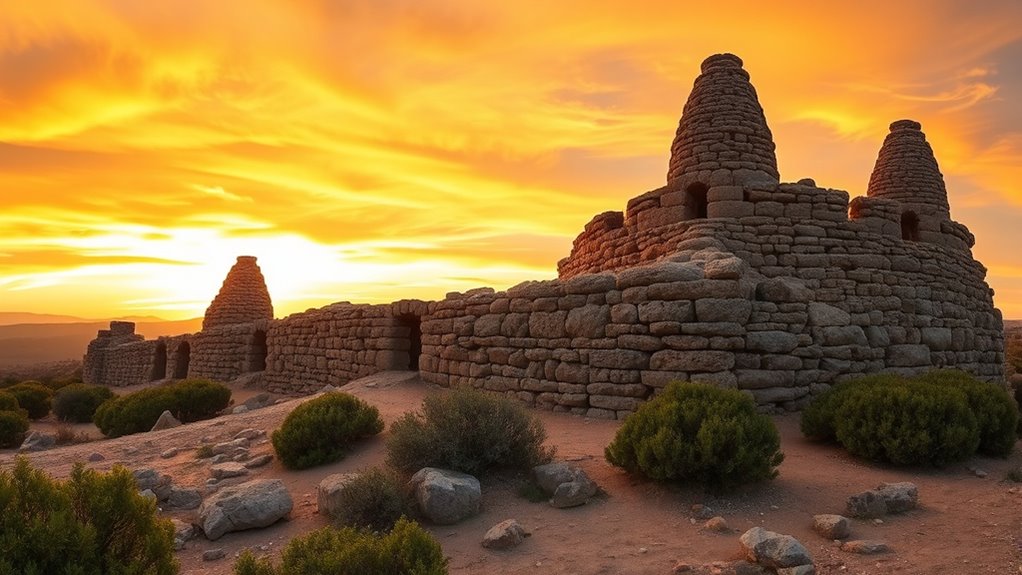
You can see that nuraghi served as more than just defensive structures—they acted as social and political hubs for Sardinian communities. Their strategic locations and construction made them focal points for religious rituals and communal gatherings. Together, these roles helped shape the complex society that thrived on the island long ago. Their multifunctional nature allowed Nuraghi to support various aspects of daily life, from governance to spiritual practices.
Defensive Settlements
Built with strategic purpose in mind, nuraghi served as vital defensive structures for ancient Sardinian communities. They were often placed on elevated sites, giving you a commanding view of the surrounding landscape and enabling early detection of threats. Their thick, dry stone walls and multiple towers created a formidable barrier against invaders. Inside, complex chambers and staircases hint at sophisticated engineering designed for quick defense. The surrounding settlements, with circular huts and outer walls, formed a fortified network protecting both people and resources. Additionally, best anime movies reflect the rich storytelling traditions that have influenced various cultural expressions throughout history.
Social and Political Centers
Ancient Sardinian society centered around nuraghi as key social and political hubs, where clan leaders and chieftains established their authority. These structures, initially simple dwellings, grew into complex compounds that reflected social hierarchy, with taller nuraghi symbolizing greater power and status. Positioned to maintain visual contact with neighboring nuraghi, they enabled communication and territorial oversight. Nuraghi complexes expanded over time, adding towers and enclosures to accommodate larger groups and centralized governance. They served as focal points for communities, hosting social gatherings, political negotiations, and administrative functions. Surrounding settlements of circular huts indicate organized, cooperative living. Nuraghi also played a strategic role in controlling land, trade routes, and resources, reinforcing the social and political structure of prehistoric Sardinia. The strategic placement of nuraghi facilitated communication and territorial control among different clans and tribes, strengthening their influence across the island. Additionally, the defensive features of many nuraghi suggest their importance in safeguarding communities from external threats.
Religious and Ritual Sites
Nuraghi played a pivotal role in the spiritual life of prehistoric Sardinian society, often situated near sacred water sources like wells and megalithic tombs. This proximity suggests they were integral to religious practices involving water veneration and ceremonial gatherings. Sacred wells, often architecturally sophisticated, served as sites for water worship and rituals connected to nuraghi complexes. Artifacts and devices linked to ritual use found nearby reinforce their spiritual significance beyond defense or habitation. These sites often included:
- Altars and niches for offerings and religious rites
- Complex internal chambers for ceremonial activities
- Alignments with astronomical events, emphasizing cosmological importance. Astrological charts have helped researchers understand how these alignments may have been intentional, linking them to celestial phenomena. Together, these features highlight nuraghi’s multifaceted role as spiritual, ritual, and cosmological centers. Archaeological discoveries have also revealed that some nuraghi contained symbolic carvings and paintings that may have held religious meanings, further underscoring their importance in ritual life.
Cultural Significance and Mythological Connections
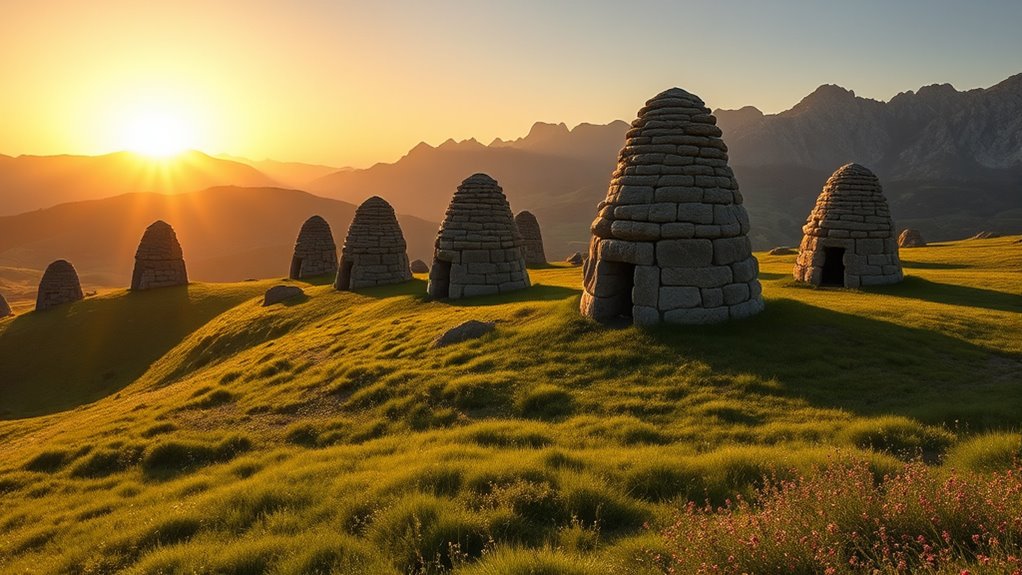
The Nuragic civilization’s sacred sites and monumental structures reveal a deep connection between their physical environment and spiritual beliefs. You see, their religion centered on fertility themes, linking male Bull-Sun power with female Water-Moon power. Mythological figures like half-man, half-bull sculptures and two-headed deer likely represented divine forces. Central deities included a Mother Goddess and a God-Father (Babai), embodying fertility and protection. Sacred symbols like bulls, doves, and *pintadera* discs played roles in rituals. Nuraghi towers are often near megalithic monuments, sacred wells, and tombs, indicating their spiritual significance. These structures symbolize cultural identity and mythic protection, connecting Sardinia’s history to divine and heroic origins, reinforcing their importance through folklore and myth. The alignment of these structures with celestial events further underscores their role in sacred ceremonies and calendar observances. Additionally, the archaeological findings demonstrate how these sites served as centers for communal worship and cultural continuity.
The Evolution of Nuraghe Complexes Over Time
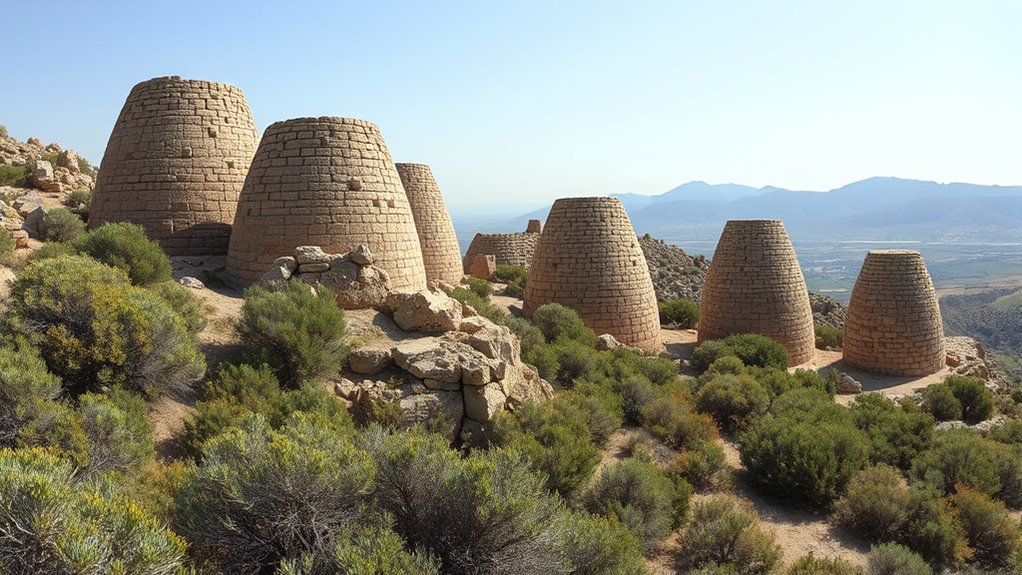
As you examine the evolution of nuraghe complexes, you’ll notice how their structures grew more intricate over time, reflecting advances in engineering and social organization. The shift from simple protonuraghi to multi-towered, tholos-equipped fortresses shows a clear move toward greater complexity. This transformation also indicates changes in their functions, from basic dwellings to symbols of power, defense, and community cohesion. Additionally, the incorporation of diverse materials highlights technological advancements and cultural influences over different periods.
Development of Structural Complexity
Over time, Sardinian builders advanced the architectural complexity of nuraghe structures, transforming simple towers into sophisticated fortress-like complexes. They evolved from basic single towers with beehive chambers to multi-tower arrangements connected by defensive walls. Some nuraghi featured multiple levels, with up to three superimposed chambers, increasing their structural sophistication. During the Middle to Late Bronze Age, construction surged, and nuraghi became strategic, multi-component fortresses integrated into settlements. By the Final Bronze and Early Iron Age, construction slowed, but nuraghi shifted in purpose, becoming centers for religious and communal activities. They were often remodeled and reused, reflecting societal changes. These developments show an increasing mastery of stonework and defensive design, transforming nuraghe from simple towers into complex symbols of social and strategic importance. Notably, the incorporation of elaborate defensive features like fortified gates and multiple curtain walls further exemplifies their evolving complexity and strategic importance. Additionally, the use of advanced construction techniques during this period highlights the increasing sophistication of Sardinian architecture.
Transition in Functionality
Throughout their development, nuraghe structures shifted from primarily serving defensive and residential functions to roles centered on religious and ceremonial activities. Initially, during the Middle Bronze Age, they provided shelter, storage, and defense, with features like slits for surveillance. By the Late Bronze Age, complex multi-tower nuraghe on hilltops reinforced protection and social hierarchy. As time progressed into the Final Bronze and Early Iron Ages, nuraghe became religious centers, evident in artifacts like offerings and sacred shrines. They also integrated into village layouts, supporting communal and ceremonial life. Despite no new constructions after the Iron Age, existing nuraghe were adapted for spiritual uses, highlighting their enduring cultural significance. These structures are considered archaeological monuments that offer insights into prehistoric Sardinian society.
Discovering Archaeological Insights and Preservation Efforts
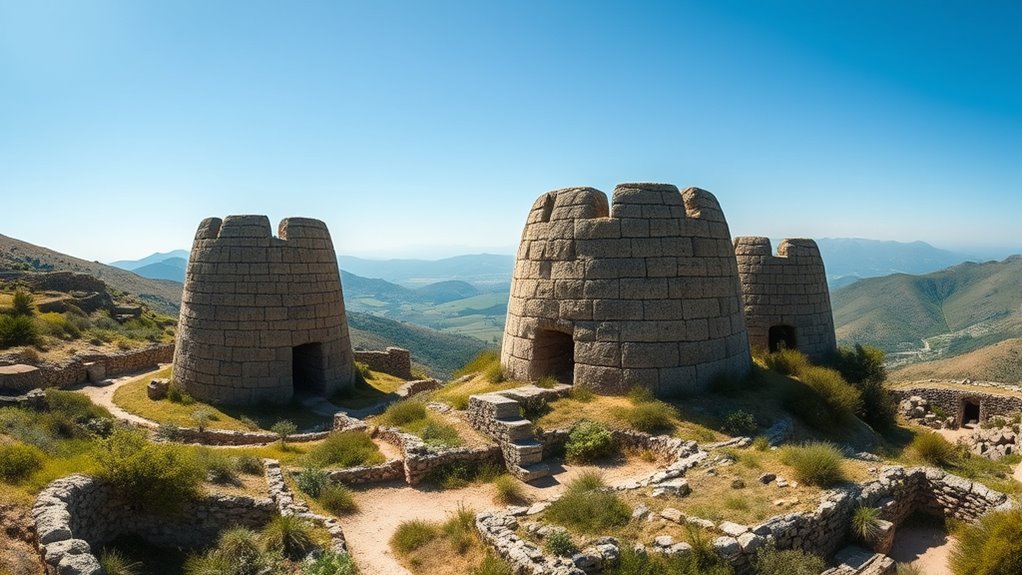
Discovering archaeological insights in Sardinia’s Nuraghi sites reveals a wealth of information about Bronze Age society, craftsmanship, and spiritual life. When you explore sites like Su Nuraxi di Barumini, you see impressive defensive structures, central towers, and complex layouts that reflect advanced engineering. Excavations uncover artifacts such as ceramic vessels, metal tools, and jewelry, which shed light on daily life and social hierarchies. You’ll also encounter monumental sculptures like the Giants of Mont’e Prama, revealing spiritual or ceremonial significance. Preservation efforts focus on maintaining structural integrity through ongoing conservation, guided tours, and onsite museums. Thousands of Nuraghe structures have been discovered, providing a broad understanding of Sardinia’s prehistoric architecture and community organization. Well-preserved towers and chambers offer insights into ancient construction techniques. Artifacts reveal social roles, craftsmanship, and cultural practices. Additionally, archaeological research plays a vital role in uncovering new discoveries and understanding the region’s history. Ongoing efforts aim to protect these UNESCO sites for future generations.
Nuraghi’s Influence on Later Architectural Styles
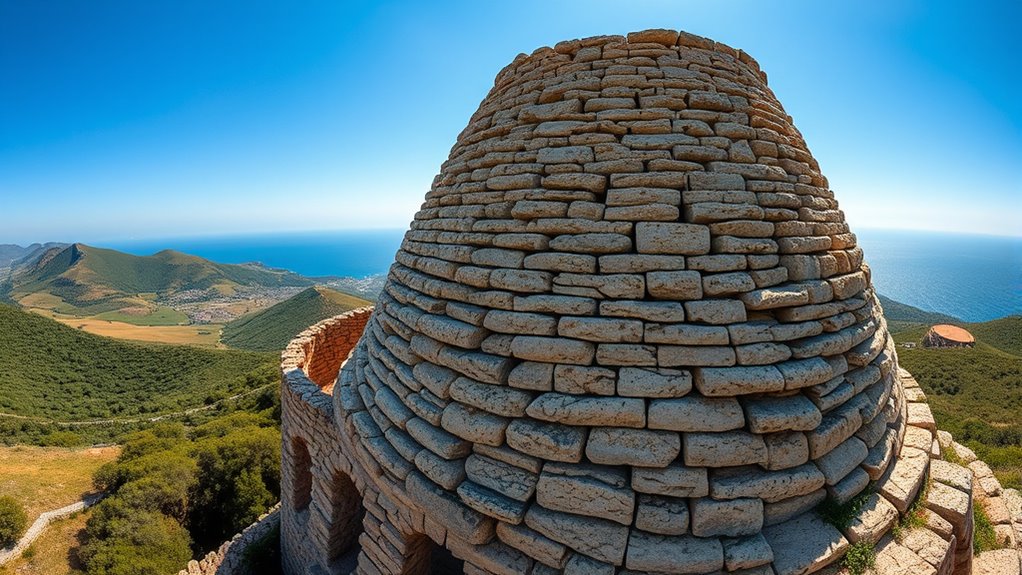
Nuraghi have profoundly influenced the development of later architectural styles in Sardinia and the wider Mediterranean region. Their massive, dry-stone construction and truncated conical shape set a standard for fortified architecture, inspiring medieval castles and watchtowers. Complex nuraghi like Su Nuraxi, with multiple towers and passageways, demonstrated advanced defensive techniques that echoed in later fortifications. The use of corbel arches and vaulted chambers in nuraghi informed Sardinian building traditions, emphasizing durability and engineering ingenuity. Their symbolic role as social and ritual centers also shaped architectural expressions of power and community identity, influencing church towers and civil structures. Furthermore, nuraghi’s techniques and monumental forms spread through trade and contact, impacting architectural styles in Corsica, the Balearic Islands, and Italy’s Mediterranean coast. These structures served not only as fortresses but also as symbols of political authority and social cohesion across different periods.
The Broader Context of Prehistoric Sardinian Culture
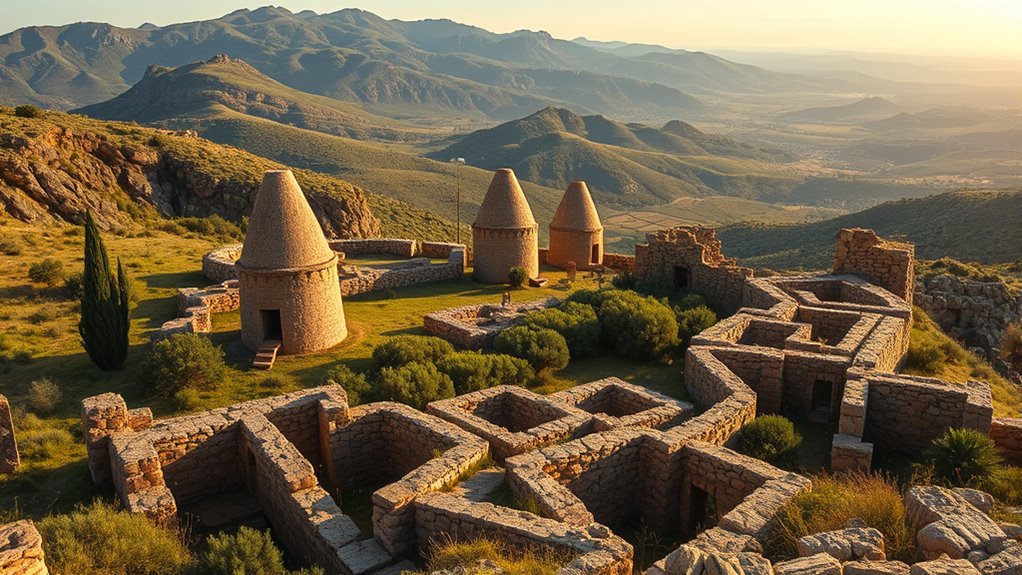
Prehistoric Sardinian culture developed over thousands of years, shaped by diverse environmental, social, and technological influences. You can see this in features like the lithic workshops from the Paleolithic era and the early settlements during the Ozieri culture, which mastered agriculture and trade. Sardinia was once connected to Corsica during the Ice Age, facilitating human movement and cultural exchange. You’ll find impressive megalithic monuments such as *perdas fittas*, dolmens, and *domus de Janas*, revealing spiritual beliefs and social organization. Notable artifacts include early silver and copper tools, showing advanced metallurgy. The arrival of the Beaker culture introduced new pottery styles and rituals, reflecting ongoing cultural interactions across the Mediterranean and Europe. Archaeogenetic studies indicate a remarkable genetic continuity among prehistoric populations, emphasizing the island’s long-term demographic stability. These elements create a rich, interconnected prehistoric tapestry.
Exploring Nuraghi Through Modern Tourism and Education
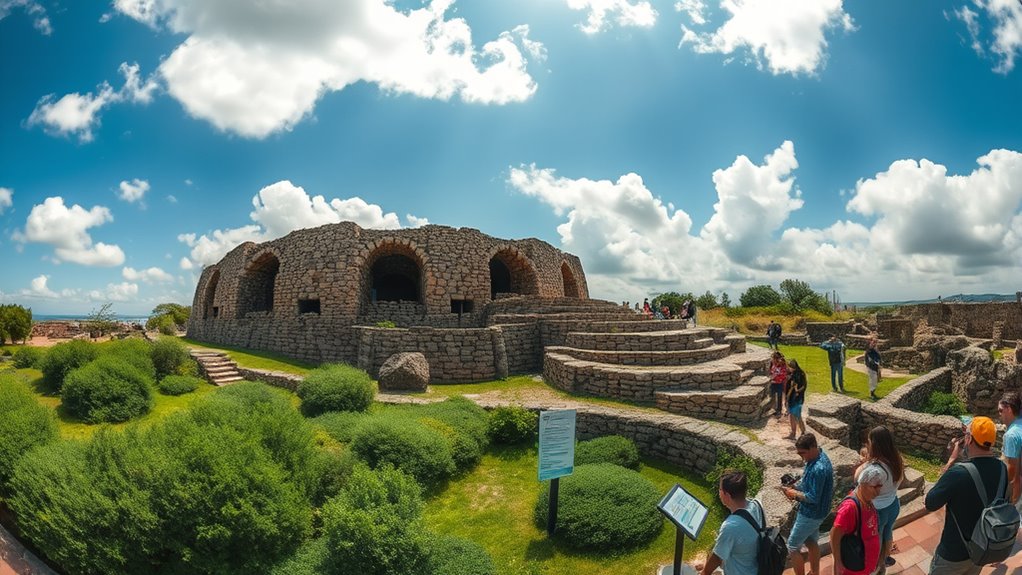
Modern tourism and education play a essential role in highlighting Sardinia’s ancient nuraghi, transforming these archaeological marvels into vibrant cultural assets. You can explore nuraghi through immersive tours, museums, and digital tools that reveal their history and significance. Despite only 10% of tourists visiting nuraghi, there’s huge growth potential, especially with UNESCO recognition boosting their profile. Infrastructure improvements support longer stays, and organized excursions make these sites more accessible. Educational programs target schools and universities, fostering deeper understanding. The table below highlights key aspects shaping nuraghi tourism:
| Aspect | Current Status | Future Potential |
|---|---|---|
| Visitor Numbers | About 10% of tourists visit nuraghi | Growth with UNESCO recognition |
| Economic Impact | ~1 billion euros annually | Increased tourism revenue |
| Infrastructure Development | Hotels and guided tours support visits | Expanded facilities and accessibility |
| Educational Initiatives | Museums, apps, and programs | Broader engagement and awareness |
Frequently Asked Questions
What Materials Were Used to Build Nuraghi Besides Stone?
You’re wondering what materials, besides stone, were used to build nuraghi. While stone was primary, archaeologists suggest organic materials like wood may have supported roofs or floors, though evidence is limited. Mud or clay might have been used as binders or fillers inside the structures. Metal fittings, such as copper or bronze, could reinforce certain parts, but these materials played minor roles compared to the dominant stone construction.
How Did Nuraghi Influence Later Mediterranean Architecture?
You see, nuraghi greatly influenced later Mediterranean architecture by pioneering advanced dry stone construction and complex layouts. Their conical towers, thick walls, and strategic hilltop placements inspired medieval fortifications and coastal defenses. You’ll notice their multifunctional design—blending social, ritual, and defensive functions—shaping regional building traditions. Their engineering innovations, like large limestone blocks and geometric plans, set benchmarks that many cultures adopted, leaving a lasting architectural legacy across the Mediterranean.
Are There Any Nuraghi With Unique or Unusual Architectural Features?
You’ll find that some nuraghi have truly unique features. For example, a few showcase polygonal shapes or irregular layouts that adapt to local terrain, while others include complex multi-tower designs with interconnected chambers. Some feature innovative corbelled vaults, spiral staircases, or strategic narrow entrances for defense. These architectural innovations highlight the ingenuity of their builders, making these structures stand out as versatile, multifunctional, and symbolically significant within their communities.
What Evidence Links Nuraghi to Ancient Trade or Cultural Exchanges?
Think of nuraghi as ancient trade beacons, shining signals across the Mediterranean. You see evidence like imported amber, copper isotopes reaching Scandinavia, and coins washing ashore suggests Sardinia played a bustling role in long-distance exchanges. Artifacts from Nuragic sites spread across Italy, Spain, and Greece, confirming these structures weren’t just defensive towers but hubs of cultural and commercial interaction, connecting Sardinia to a wider world.
How Do Nuraghi Compare to Other Prehistoric Megalithic Structures Worldwide?
When comparing nuraghi to other prehistoric megalithic structures worldwide, you’ll notice they’re unique in purpose and design. Nuraghi are multi-roomed towers built for defense and community use, unlike European dolmens and menhirs, which mainly serve burial or ritual functions. While Göbekli Tepe features massive pillars for temples, nuraghi stand as fortified settlements. Their localized development and distinct functions set them apart from broader megalithic traditions globally.
Conclusion
As you explore Nuraghi, you uncover their origins, marvel at their engineering, and connect with Sardinia’s ancient past. You see how each stone tells a story, how each site reveals a society’s strength, and how their legacy influences modern architecture. You appreciate their cultural significance, embrace their mythological roots, and recognize their ongoing importance. In understanding Nuraghi, you embrace Sardinia’s history, its resilience, and its timeless spirit.



